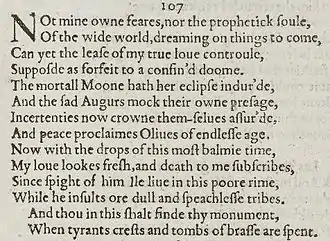Sonnet 107
Sonnet 107 is one of 154 sonnets written by the English playwright and poet William Shakespeare. It is a member of the Fair Youth sequence, in which the poet expresses his love towards a young man.
| Sonnet 107 | |||||||
|---|---|---|---|---|---|---|---|
 Sonnet 107 in the 1609 Quarto | |||||||
| |||||||
Synopsis
This poem repeats the theme of others, notably sonnet 18, that the poem itself will survive human mortality, and both the poet and Fair Youth will achieve immortality through it. In this case all the hazards of an unpredictable future are added to the inevitability of mortality.
Structure
Sonnet 107 is an English or Shakespearean sonnet. The English sonnet has three quatrains, followed by a final rhyming couplet. It follows the typical rhyme scheme of the form ABAB CDCD EFEF GG and is composed in iambic pentameter, a type of poetic metre based on five pairs of metrically weak/strong syllabic positions. The 14th line exemplifies a regular iambic pentameter:
× / × / × / × / × / When tyrants' crests and tombs of brass are spent. (107.14)
- / = ictus, a metrically strong syllabic position. × = nonictus.
Frequent variations make this sonnet metrically complex. The 2nd line begins with the rightward movement of the first ictus (resulting in a four-position figure, × × / /, sometimes referred to as a minor ionic), and follows with a mid-line reversal ("dreaming"), which places three ictuses in a row:
× × / / / × × / × / Of the wide world dreaming on things to come, (107.2)
Both of these metrical variations reappear in the poem: Mid-line reversals occur in lines 1 and 8, and an initial reversal occurs in line 9. Minor ionics occur in line 6 and potentially in lines 3 and 11.
In line 4, "confined" is "double-stressed in Shakespeare's English, and follow[s] the Alternating Stress Rule" moving its principle stress to the first syllable in the context of "confined doom".[2]
Analysis
The line about the eclipse of the moon has sometimes been interpreted as reference to death of Queen Elizabeth I
Sonnet 107 can also be seen as referring to Doomsday. The sonneteer's love cannot even be ended by the "confined doom." The eclipse of the moon, then, like the "sad augurs," refers to a sign that might presage the Last Judgment. While everything else (the "tombs of brass" for example) comes to an end, the "poor rhyme" will be the last thing to go. As in Sonnet 55, the power of the sonnet to give life to the young man -- or, here, to serve as a monument to him -- will only be overshadowed when that young man literally comes forth from the grave on Judgment Day.
Notes
- Pooler, C[harles] Knox, ed. (1918). The Works of Shakespeare: Sonnets. The Arden Shakespeare [1st series]. London: Methuen & Company. OCLC 4770201.
- Groves, Peter (2013). Rhythm and Meaning in Shakespeare: A Guide for Readers and Actors. Melbourne: Monash University Publishing. pp. 166, 168. ISBN 978-1-921867-81-1.
References
- First edition and facsimile
- Shakespeare, William (1609). Shake-speares Sonnets: Never Before Imprinted. London: Thomas Thorpe.
- Lee, Sidney, ed. (1905). Shakespeares Sonnets: Being a reproduction in facsimile of the first edition. Oxford: Clarendon Press. OCLC 458829162.
- Variorum editions
- Alden, Raymond Macdonald, ed. (1916). The Sonnets of Shakespeare. Boston: Houghton Mifflin Company. OCLC 234756.
- Rollins, Hyder Edward, ed. (1944). A New Variorum Edition of Shakespeare: The Sonnets [2 Volumes]. Philadelphia: J. B. Lippincott & Co. OCLC 6028485.
- Modern critical editions
- Atkins, Carl D., ed. (2007). Shakespeare's Sonnets: With Three Hundred Years of Commentary. Madison: Fairleigh Dickinson University Press. ISBN 978-0-8386-4163-7. OCLC 86090499.
- Booth, Stephen, ed. (2000) [1st ed. 1977]. Shakespeare's Sonnets (Rev. ed.). New Haven: Yale Nota Bene. ISBN 0-300-01959-9. OCLC 2968040.
- Burrow, Colin, ed. (2002). The Complete Sonnets and Poems. The Oxford Shakespeare. Oxford: Oxford University Press. ISBN 978-0192819338. OCLC 48532938.
- Duncan-Jones, Katherine, ed. (2010) [1st ed. 1997]. Shakespeare's Sonnets. The Arden Shakespeare, Third Series (Rev. ed.). London: Bloomsbury. ISBN 978-1-4080-1797-5. OCLC 755065951.
- Evans, G. Blakemore, ed. (1996). The Sonnets. The New Cambridge Shakespeare. Cambridge: Cambridge University Press. ISBN 978-0521294034. OCLC 32272082.
- Kerrigan, John, ed. (1995) [1st ed. 1986]. The Sonnets ; and, A Lover's Complaint. New Penguin Shakespeare (Rev. ed.). Penguin Books. ISBN 0-14-070732-8. OCLC 15018446.
- Mowat, Barbara A.; Werstine, Paul, eds. (2006). Shakespeare's Sonnets & Poems. Folger Shakespeare Library. New York: Washington Square Press. ISBN 978-0743273282. OCLC 64594469.
- Orgel, Stephen, ed. (2001). The Sonnets. The Pelican Shakespeare (Rev. ed.). New York: Penguin Books. ISBN 978-0140714531. OCLC 46683809.
- Vendler, Helen, ed. (1997). The Art of Shakespeare's Sonnets. Cambridge, MA: The Belknap Press of Harvard University Press. ISBN 0-674-63712-7. OCLC 36806589.
.png.webp)
